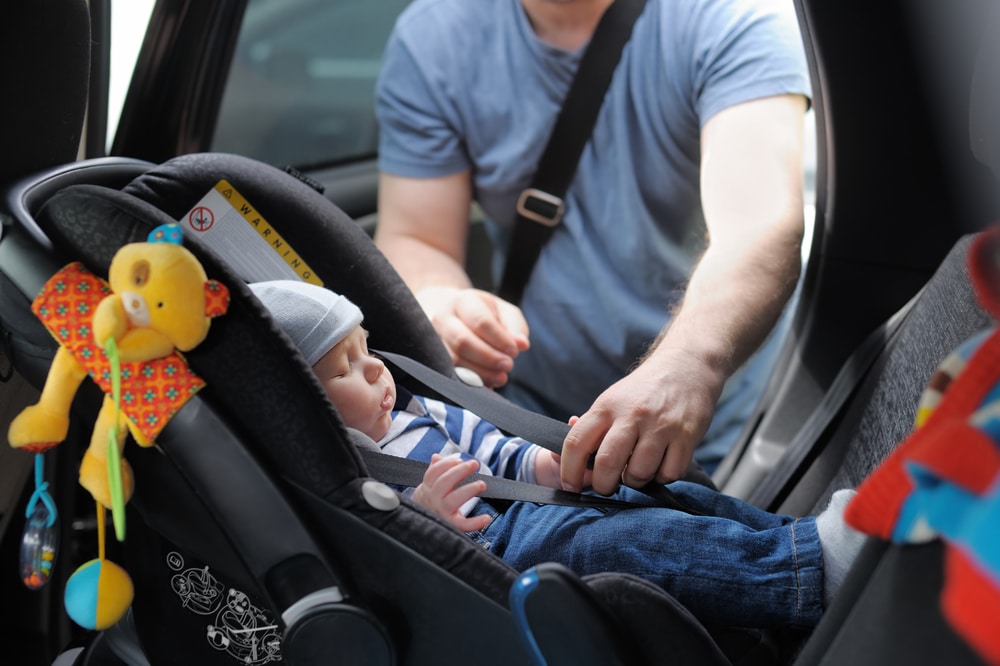Each state in the US will have slightly different car seat laws for children, but mainly you can rely on the same federal car seat safety guidelines regardless of where you live. Car seats also have different height and weight requirements that vary between brands and types.
We’ll cover the basics of car seats for kids, useful resources for parents and caregivers, and discuss the recommendations and Idaho car seat laws that apply.

Idaho Laws and Other Car Seat Basics
There are several different types of car seats that you can use in your vehicle that adheres to the Idaho car seat laws. Each type of car seat has its pros and cons, but some feature designs are for children of specific age ranges.
Car Seat Types
Here are the primary car seat types you may hear referred to:
- Infant Car Seats
- Convertible Car Seats
- Boosters
- Front-facing Car Seats
- Rear-facing Car Seats
Rear-facing car seats are the best option in terms of safety because they protect the neck, head, and spine best during a crash. Rear-facing car seats are best until your child is two years old or as long as possible, provided they fit within the limits for height and weight.
Car seats that are forward-facing work best when your child is over two and can no longer fit within the limits of a rear-facing seat. Forward-facing seats are slightly less safe than rear-facing seats in a collision, and you should always look for one that has a five-point harness.
Your child can use their forward-facing seat until they have outgrown the height and weight limits set for that product. Once they have outgrown this type of seat, you can switch them to a booster seat that works by raising them so that they can properly use a seat belt.
Most kids aren’t large enough to properly use a seat belt after they outgrow a rear-facing or forward-facing seat. If you plan to use a booster seat with your child, it’s vital that they stay seated and remain buckled whenever the car is in motion.
There aren’t specific booster seat laws Idaho has adopted, but using a booster seat ensures your child stays restrained when they are too small for a seat belt to work correctly during a collision.
Convertible car seats are a newer invention that allows the parents to remove inserts and expand the seat’s internal space as their child grows. This type of car seat often has a higher weight and height limit, so your child won’t outgrow it as quickly, and they can face the rear or the front of the vehicle.
A convertible car seat is suitable for infants, but an infant car seat is not suitable for all babies. Many babies outgrow an infant car seat quickly as the weight limits are lower than with other types of car seats. Whichever car seat you choose, it’s important that it meet all applicable Idaho car seat laws and other federal requirements.
Applicable Laws
The car seat laws Idaho has require that your child stay restrained in an appropriate car seat or other restraint that meets the federal motor vehicle safety standards, number 213.
There are no Idaho child seat laws that tell parents how long their children must sit in a rear-facing seat, but the recommendation states they should use this type of car seat until they are at least two years old.
Exemptions
There are some exemptions to Idaho car seat laws for when you need to nurse or take care of your child’s immediate needs; however, most experts warn parents and caregivers never to remove their baby from the car seat while the car is moving.
Removing them from the car seat puts your baby at risk during a collision and results in a much higher risk of serious injury than if they were securely in their car seat.
Violations and Penalties
Idaho child seat laws are what’s called “primary laws,” and if someone in your vehicle is unrestrained and under 18 years old, you’ll be fined and may have to pay court costs. Fines for this infraction in Idaho are relatively low, with fines reported around $10 and court costs amounting to $50 to $67.
Car Seat Safety and Resources
Car seats are often used incorrectly even by the most well-meaning parents, and it’s often essential to use a specific type of seat with children of a certain age range for the highest safety.
To keep your child as safe as you can, you can get your car seat checked by a technician and follow specific guidelines for each type of seat recommended. The Idaho Transportation Department reports that thousands of crashes occur on roads throughout the year, and their laws often stem from the resulting data collected.
Crash reports get completed for all crashes that involve a vehicle and at least $1500 in damage, and law enforcement officers identify factors that contribute to crashes, including:
- The vehicle
- Operator information
- Environmental factors (location and other conditions)
Idaho also has a Child Passenger Safety Centralized Leadership Coordinator, Carma McKinnon, who works for the Lemhi County Sheriff’s Office in Salmon, Idaho.
As part of this department’s campaign to ensure proper car seat usage, you can get a free pocket card with restraint basics to assist parents and caregivers. This card is available from the Occupant Protection Program, and you can contact the Idaho Transportation Department with other questions or for more information.
Car Seat Recommendations by Age
Car seat recommendations change as your child grows or gets older, so it’s best to be vigilant about the height and weight limits on your child’s car seat, their increasing height and weight, and what recommendations apply.
Babies and Toddlers Up to Two Years Old

You can put your infant in an infant car seat or a convertible car seat provided that they meet the minimum height and weight limits. It’s best to use these types of rear-facing seats for as long as your child fits in them or until they are at least two years old.
Check the height and weight limits of different car seat brands to find one with a higher limit that will allow your child to use it longer. Most infant seats will have a lower weight limit of somewhere around 20-25 pounds, while some convertible car seats safely accommodate a child that weighs approximately 50 pounds.
Two to Four Year Old Children

When your child is older than two, you can choose to put them in a forward-facing car seat or allow them to remain rear-facing for added safety. The Idaho Transportation Department recommendations suggest leaving your child in a rear-facing seat until they are around four years old or when they weigh between forty and sixty-five pounds.
Four to Eight Years Old

There are no specific booster laws in Idaho, but at this age, your child is likely ready for a booster seat with a high back that allows the seat belt to cross their body at the appropriate locations. If your child is under 4’9″ tall, a booster seat gets highly recommended as most kids aren’t big enough yet to fit into a typical car seat correctly.
Related States: Iowa Car Seat Laws | Minnesota Car Seat Laws
Conclusion
Idaho car seat laws follow the same federal guidelines as other US states, with a few differences when it comes to regulations for specific seat types, penalties, and fines.
While there are a few exemptions to these laws, some of the exemptions may put your child at significant risk during a collision in a moving vehicle, and parents and caregivers should be vigilant about their child’s size and the most appropriate car seat type.






